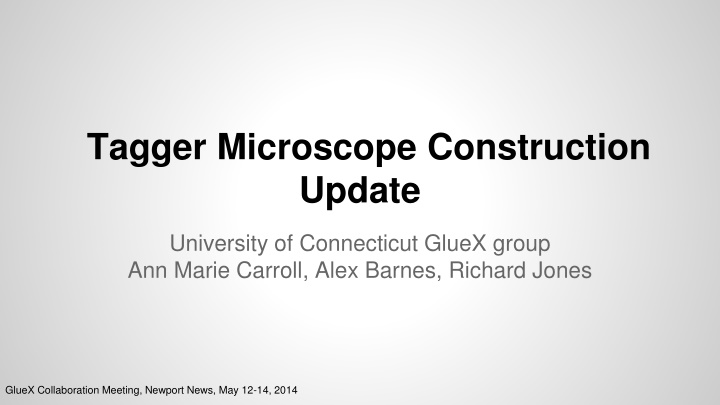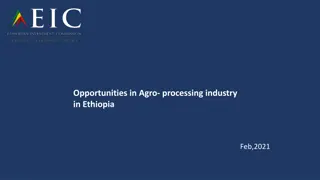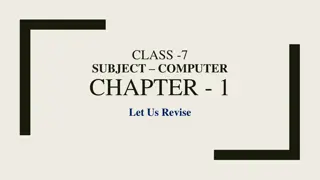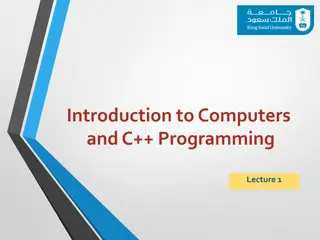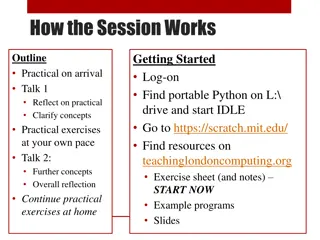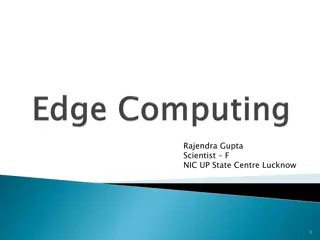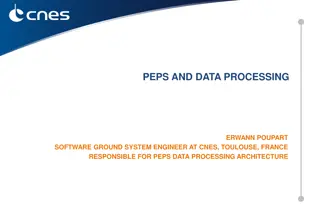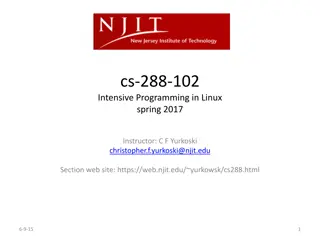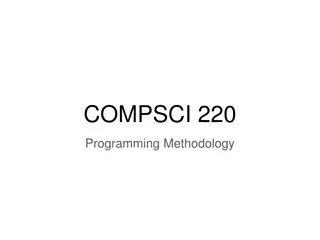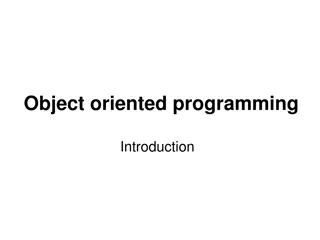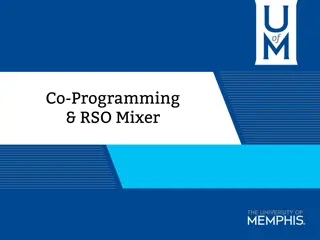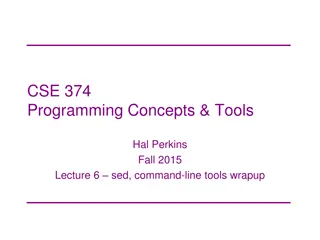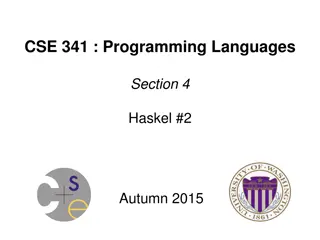Introduction to Processing Programming: Who Is It For and Key Concepts
Processing is an open-source programming language focused on visual arts and electronic media. This chapter covers the target audience, incremental development, algorithms, and the foundation of the Processing language. Learn about the coordinate systems, simple shapes, functions, variables, and more. Dive into practical exercises to enhance your understanding of programming concepts.
Download Presentation

Please find below an Image/Link to download the presentation.
The content on the website is provided AS IS for your information and personal use only. It may not be sold, licensed, or shared on other websites without obtaining consent from the author.If you encounter any issues during the download, it is possible that the publisher has removed the file from their server.
You are allowed to download the files provided on this website for personal or commercial use, subject to the condition that they are used lawfully. All files are the property of their respective owners.
The content on the website is provided AS IS for your information and personal use only. It may not be sold, licensed, or shared on other websites without obtaining consent from the author.
E N D
Presentation Transcript
Tagger Microscope Construction Update University of Connecticut GlueX group Ann Marie Carroll, Alex Barnes, Richard Jones GlueX Collaboration Meeting, Newport News, May 12-14, 2014
Outline Fiber bundle production - Ann Marie Carroll Overview of production stage Light yield measurements Manufacturer s blunder Absolute photon yields - Richard Jones Comparison with prototype Comparison with simulation Task list prior to October run - Alex Barnes 1 GlueX Collaboration Meeting, Newport News, May 12-14, 2014
Quick overview of steps in bundle production Rough cut Straighten light guide End-mill to final length Polish non-fused ends Fuse 2 cm of scintillator to 166 cm light guide Bend: s-bend near scintillator end, 110 bend near midpoint Paint: 20 micron layer of titanium dioxide covering first 80 cm Glue: holds fibers in precise mechanical alignment, first 20 cm 2 GlueX Collaboration Meeting, Newport News, May 12-14, 2014
Fiber Light Yield Measurement Red laser diode with a diffuser in a 200 kHz pulsing circuit. Black out material separating pulser end from SiPM s Minimal wetted surface contact 3 GlueX Collaboration Meeting, Newport News, May 12-14, 2014
Manufacturers Blunder Cosmic tests: First production bundle Fused Bent Painted Glued 1/4 expected yield! Reason: missing cladding Core is polystyrene First cladding is 4% of core size - acrylic Second cladding is 2% of core size fluor-acrylic Total fiber size is 2mm x 2mm Procedures designed for double-clad scintillators and double-clad light guides Single clad Double clad Prototype worked as expected, and easily met experimental needs. (double-clad light guide) Visually difficult to distinguish difference 4 GlueX Collaboration Meeting, Newport News, May 12-14, 2014
. Fibers categorized according to production steps: C - Cut off the spool, never otherwise touched. S - Cut, straightened, but not fused or otherwise touched. F - Cut, straightened, fused, bent, but not otherwise touched. B - Cut, straightened, fused, bent, but not otherwise touched. P - Cut, straightened, fused, bent, painted, but not glued. R - Cut, straightened, fused, bent, painted, and then had the paint removed. G - Cut, straightened, fused, bent, painted, and glued. 5 GlueX Collaboration Meeting, Newport News, May 12-14, 2014
C Mean = 891.3 ADC count. ~ 70 pixels/pulse B Mean = 624 ADC count. ~ 50 pixels / pulse P Mean = 176.1 ADC count. ~15 pixels/pulse S Mean = 1096 ADC count. ~ 85 pixels/pulse Not expected! 6 GlueX Collaboration Meeting, Newport News, May 12-14, 2014
Paint removed: Type R ~ 1 pixel/pulse After paint is removed He s dead Jim! Never painted 7 GlueX Collaboration Meeting, Newport News, May 12-14, 2014
Optical Crosstalk Negligible optical crosstalk even without paper spacing <1% Paint not necessary 8 GlueX Collaboration Meeting, Newport News, May 12-14, 2014
No more gluing Gluing was permanent. With new mount, individual fibers can be replaced if needed. 3 Kapton straps hold fibers in place. Plates and gasket fit tight popsicle stick mount placement. Gasket keeps straps from moving. Keeps the fibers square and in line. 9 GlueX Collaboration Meeting, Newport News, May 12-14, 2014
Final product will have a reflector on the face of the SciFis. Degree of misalignment horizontally is a fraction of a millimeter. Better alignment in the vertical direction where it is most necessary. Columns and rows aligned well with this mounting setup. 10 GlueX Collaboration Meeting, Newport News, May 12-14, 2014
Current Status Contracted to deliver 102 columns of fibers. Planned contingency of 24 extra columns. Can chose the best 102 columns to put in the final detector 126 columns fused already 114 columns bent, 12 columns remain unbent as of now 60 columns painted already, 48 still painted, 12 with paint removed 66 columns never painted Able to deliver 66 never painted columns (65% of our contracted columns) to JLab in one month, plus 42 additional columns performance below spec. Saint Gobain agrees to deliver 100% of original order with multi-clad light guide at zero cost, delivery date unknown (fluorinated acrylic material deficit) 11 GlueX Collaboration Meeting, Newport News, May 12-14, 2014
Absolute photon yields mean cosmic yield = (8000 /MeV) * (1.6 MeV/cm) * (mean cosmic scint path length) * (SiPM pde) * (fiber transmission fraction) * (factor for reflection) mean cosmic scint path length = 0.21 mm (from Geant) SiPM pde is 25% in this wavelength range reflection factor = 1.7 for aluminized mylar design goal 200 pixels per electron => 200ps time resolution rms minimum fiber transmission factor 1.8% 12 GlueX Collaboration Meeting, Newport News, May 12-14, 2014
Light yield from cosmic rays path length (cm) Cosmic ray simulation: path length of triggered cosmic ray in plastic scintillator, middle column is ~2.1 mm Cosmic ray 13 GlueX Collaboration Meeting, Newport News, May 12-14, 2014
Light yield from cosmic rays (from several weeks of data collection) (B-type bundle, several days of data collection) 14 GlueX Collaboration Meeting, Newport News, May 12-14, 2014
Differences of production from prototype 1. junction fused instead of glued (yield-neutral) 2. light guide 166cm instead of 80cm 3. different bend pattern, prototype bend was more severe 4. prototype was painted the full length, and glued 5. simulation points to cladding: single-clad is highly sensitive o bends, paint, scratches, random defects all lead to significant loss o second cladding layer reduces sensitivity by ~1 order magnitude 15 GlueX Collaboration Meeting, Newport News, May 12-14, 2014
Tagger Microscope Installation Alex Barnes (moving to JLab after H2014) GlueX Collaboration Meeting, Newport News, May 12-14, 2014
Data Monitoring and Calibration Pulse height spectra in the TAGM counters Time spectra relative to the accelerator clock Total rates per TAGM channel Things to monitor online for the tagger microscope Measure pedestals for all FADC channels, time offsets for F1TDCs Calibrate the individual channel gains from pulse height spectra Measure time-pulse height correlations to derive optimal time-walk corrections Run in raw mode occasionally to make sure pulse window is properly aligned with actual pulses relative to trigger 1 GlueX Collaboration Meeting, Newport News, May 12-14, 2014
Control and Monitoring Software for Microscope Interface for controlling TAGM power supplies Interface for controlling SiPM preamplifiers Bias voltages (15 SiPMs x 34 boards = 510 voltages) Gain mode (1x, 14x) Interface for controlling TAGM alignment 3 stepper motors Interface for slow controls monitoring DAC health voltage (1 for each control board, 17 total) Preamp reference voltages (1 per preamp, 34 total) Preamp temperatures (1 per preamp, 34 total) Alarms for values outside of acceptable ranges 2 GlueX Collaboration Meeting, Newport News, May 12-14, 2014
Active Collimator and other work Active Collimator Work with John Bartolotta to optimize the algorithm Implement algorithm and develop real-time visualization Other work Cable up the TAGM detector and run cosmic tests Write software to calibrate and monitor TAGM performance within Hall D framework 3 GlueX Collaboration Meeting, Newport News, May 12-14, 2014
